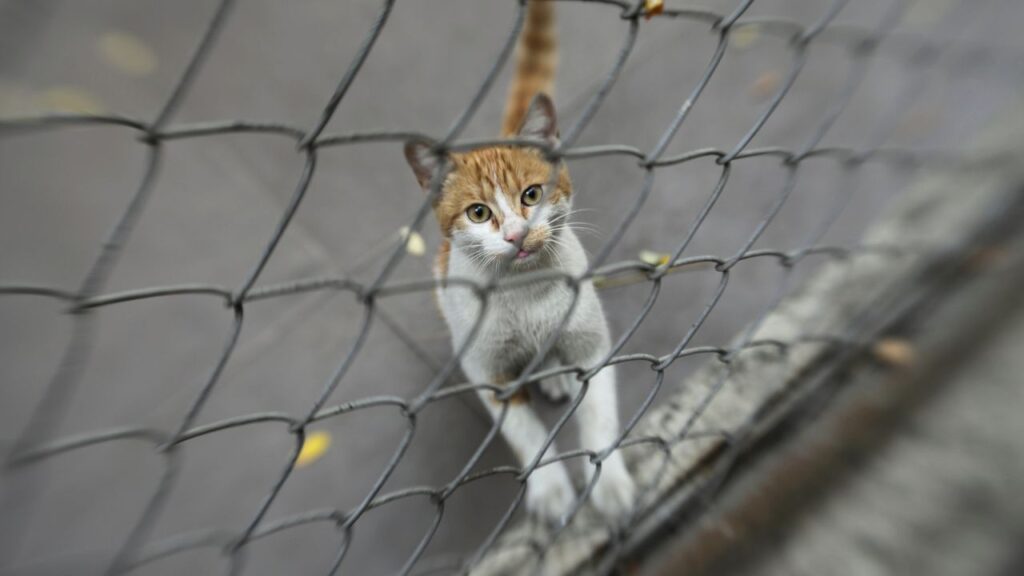Have you ever wondered what happens when your curious cat slips out the door? How far can a cat travel when lost is a pressing question for many pet owners. Cats are notorious for their exploratory nature, often venturing farther than we expect. Understanding the distances a lost cat can travel, the factors influencing their journey, and effective strategies to find them is crucial for ensuring their safe return. Let’s delve into the world of wandering cats and uncover the insights you need to keep your feline friend safe.
Contents
- 1 The Wanderlust of Cats: Why Do They Roam?
- 2 How Far Can a Cat Travel When Lost?
- 3 Real-Life Stories: How Far Have Cats Traveled?
- 4 Signs Your Cat Might Be Lost
- 5 What to Do If Your Cat Is Lost
- 6 Preventing Your Cat from Getting Lost
- 7 Essential Items to Include in a Lost Cat Kit
- 8 Personal Insights: My Experience with a Lost Cat
- 9 Frequently Asked Questions
- 10 Final Thoughts
The Wanderlust of Cats: Why Do They Roam?
Cats are natural explorers, driven by instincts that compel them to investigate their surroundings. Whether it’s the allure of new scents, the thrill of climbing, or the pursuit of prey, several factors contribute to a cat’s desire to roam.
Instinctual Drives
- Territorial Instincts: Cats are territorial animals. Exploring their environment helps them establish and maintain their territory.
- Hunting Behavior: The instinct to hunt can drive cats to chase after small animals, leading them to unfamiliar areas.
- Curiosity: Simply put, cats are curious by nature. New environments stimulate their senses and provide mental stimulation.
Fun Fact: Even well-fed cats may wander off to satisfy their hunting instincts and explore new territories.

How Far Can a Cat Travel When Lost?
So how far can a cat travel when lost? Understanding the typical distances a lost cat can travel helps set realistic expectations and informs your search strategy.
General Distance Range
On average, a lost cat can travel anywhere from a few blocks to several miles from their home. Factors such as age, health, temperament, and environmental conditions significantly influence how far a cat might go.
Factors Influencing Travel Distance
- Age and Health
- Kittens and Elderly Cats: Younger and older cats may not travel as far due to limited mobility or health issues.
- Healthy Adults: Energetic and healthy cats are more likely to venture longer distances.
- Temperament
- Bold vs. Shy: Bold, adventurous cats are more prone to traveling farther, while shy cats may stay closer to familiar areas.
- Socialization: Well-socialized cats may seek out human interaction, increasing their chances of being found.
- Environmental Factors
- Urban vs. Rural: In urban areas, cats may travel shorter distances due to barriers like busy streets, whereas in rural settings, they might roam over larger areas.
- Season and Weather: Mild weather encourages more exploration, while extreme conditions can limit a cat’s movement.
- Motivation to Return Home
- Home Territory: A strong attachment to their home territory can prompt cats to return, reducing the distance they travel.
- Availability of Resources: Access to food, water, and shelter can influence how far a cat wanders.
Real-Life Stories: How Far Have Cats Traveled?
Hearing about real-life experiences can provide a clearer picture of the potential distances lost cats might cover.
| Cat’s Name | Distance Traveled | Story Highlights |
|---|---|---|
| Luna | 10 Miles | Luna got lost during a storm and was found two weeks later in a neighbor’s yard far from home. |
| Oliver | 3 Miles | Oliver wandered into a wooded area and was reunited with his family after a community search effort. |
| Bella | 15 Miles | Bella traveled across town to find her favorite hiding spot and was found at a local park. |
| Milo | 1 Mile | Milo stayed close to home but got trapped in a garage, illustrating that not all lost cats travel far. |
Signs Your Cat Might Be Lost
Recognizing the signs that your cat is lost can help you take immediate action to find them.
Behavioral Changes
- Increased Vocalization: More meowing or crying than usual.
- Hiding: Seeking refuge in unusual places within the home or yard.
- Loss of Appetite: Eating less due to stress or fear.
Physical Indicators
- Dirty Fur: Lack of grooming if they’ve been outside.
- Injuries: Scratches or wounds from outdoor hazards.
Environmental Clues
- Missing from Regular Spots: Not found in their usual resting places.
- Unusual Smells: Returning home smelling different, indicating they’ve been outdoors.
What to Do If Your Cat Is Lost
Acting swiftly and efficiently increases the chances of reuniting with your lost cat.
Immediate Steps
- Search the Neighborhood
- Call Their Name: Use a calm and familiar voice.
- Check Hiding Spots: Look under cars, in bushes, and other secluded areas.
- Bring Their Favorite Items: Familiar scents can attract them back.
- Notify Neighbors
- Flyers: Distribute flyers with a clear photo and your contact information.
- Local Bulletin Boards: Post in community centers, vet offices, and pet stores.
- Utilize Technology
- Social Media: Share information on local community groups.
- Lost Pet Websites: Register your cat on platforms like Petfinder and PawBoost.
Extended Search Strategies
- Visit Local Shelters and Vets
- Regular Checks: Visit shelters regularly as lost cats are often brought in by good Samaritans.
- Provide Identification: Ensure your contact details are up-to-date on your cat’s ID tag or microchip information.
- Use a Pet Tracker
- GPS Collars: Equip your cat with a GPS-enabled collar for real-time tracking.
- Microchips: Ensure your cat is microchipped, as this can help identify them if found by a vet or shelter.
- Engage Community Support
- Neighborhood Search Parties: Organize or join local search efforts.
- Local Media: Utilize local newspapers, radio stations, and TV channels to spread the word.

Preventing Your Cat from Getting Lost
Prevention is always better than cure. Here are strategies to minimize the risk of your cat getting lost.
Keep Your Cat Indoors
- Safety: Indoor cats are protected from traffic, predators, and diseases.
- Longevity: Indoor cats generally live longer, healthier lives.
- Bonding: Enhanced bond with owners due to constant interaction.
Secure Outdoor Access
If you prefer to let your cat enjoy the outdoors, ensure their safety with the following measures:
- Harness Training: Train your cat to wear a harness and leash for supervised outdoor exploration.
- Enclosed Yards: Create a safe outdoor enclosure or “catio” where your cat can roam without the risk of getting lost.
- Supervised Outdoor Time: Always supervise your cat when they are outside to prevent them from wandering too far.
Identification and Microchipping
Proper identification significantly increases the chances of a lost cat being returned safely.
- Collar with ID Tag: Ensure your cat wears a collar with a current ID tag that includes your contact information.
- Microchipping: Microchip your cat and register their information with a reliable database. This provides a permanent form of identification.
Spaying and Neutering
Spaying or neutering your cat can reduce their urge to roam and decrease the likelihood of territorial disputes, which can lead to getting lost.
Essential Items to Include in a Lost Cat Kit
| Item | Purpose |
|---|---|
| Identification | Collar with ID tag, microchip information |
| Photo | Clear, recent photo for flyers and online posts |
| Food and Water | Non-perishable snacks and portable water containers |
| Litter and Scoop | Portable litter box and scooping tool |
| Familiar Items | Favorite blanket or toy to provide comfort |
| First Aid Kit | Basic supplies for any minor injuries |
| Contact Information | List of your contact details and local shelters |
| Pen and Paper | For taking notes or leaving messages if needed |
Personal Insights: My Experience with a Lost Cat
From personal experience, losing a cat is one of the most stressful situations a pet owner can face. When my beloved tabby, Whiskers, went missing, the uncertainty was overwhelming. I immediately began searching the neighborhood, distributed flyers, and reached out to local shelters. The community’s support was invaluable, and Whiskers was found safe two weeks later, thanks to the combined efforts of social media and a kind neighbor who spotted her.
Ever wondered how to handle the emotional toll of a lost pet? Staying calm, being persistent in your search, and leveraging all available resources can make a significant difference in the outcome.
Frequently Asked Questions
Does my cat miss me when I travel?
Yes, cats can miss their owners when they travel. They form strong bonds and can experience stress and anxiety during your absence. Signs such as increased vocalization, changes in appetite, and lethargy indicate that your cat might be missing you.
How far can a cat travel when lost?
On average, a lost cat can travel anywhere from a few blocks to several miles from their home. Factors such as age, health, temperament, and the environment influence the distance a cat might wander.
What should I do if my cat is lost?
Start by searching your immediate neighborhood, notifying neighbors, and distributing flyers. Utilize social media and lost pet websites, visit local shelters regularly, and consider using a pet tracker if available. Ensuring your cat has proper identification can greatly aid in their safe return.
Can a microchip help find a lost cat?
Absolutely. A microchip provides permanent identification that can be scanned by veterinarians or shelters. Ensure your microchip information is up-to-date to increase the chances of
Final Thoughts
How far can a cat travel when lost is a multifaceted question influenced by numerous factors. By understanding your cat’s behavior, implementing preventive measures, and knowing the steps to take if they go missing, you can significantly enhance the likelihood of a safe and swift reunion. Remember, every cat is unique, and their journey when lost can vary widely. Stay proactive, stay calm, and leverage community support to ensure your feline friend finds their way back home.


